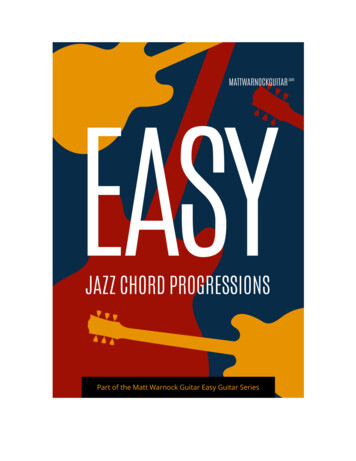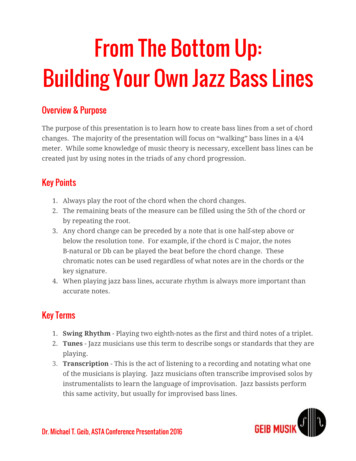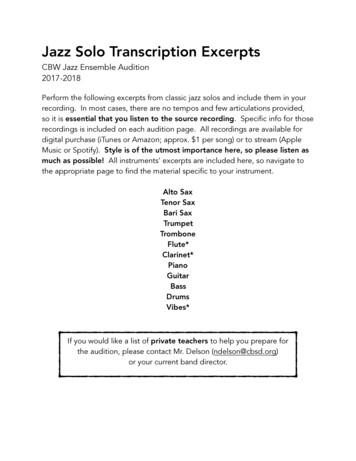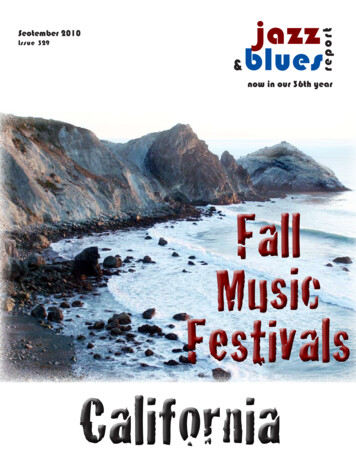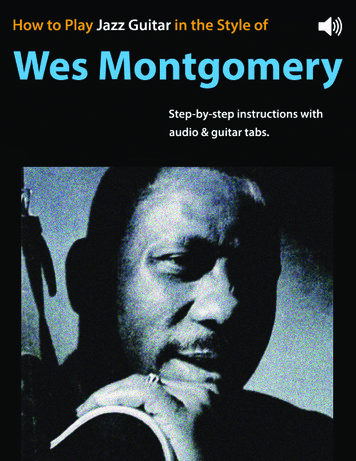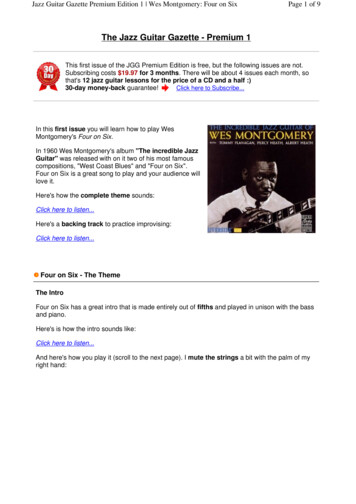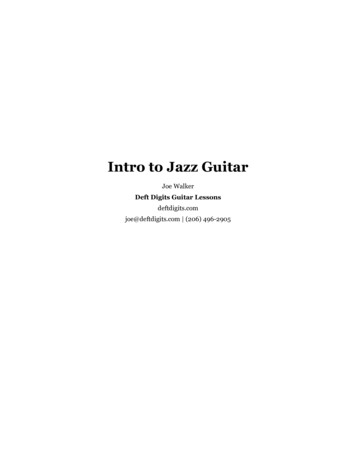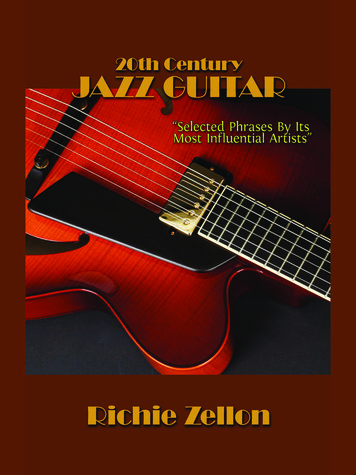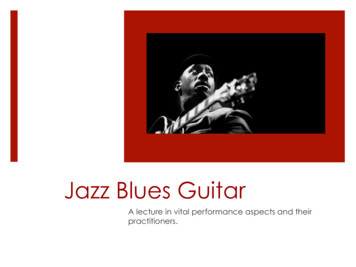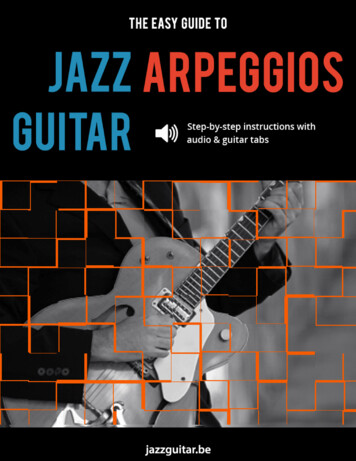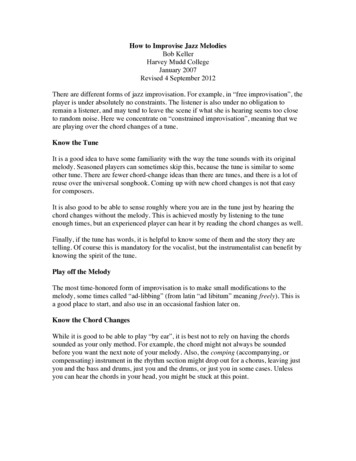
Transcription
How to Improvise Jazz MelodiesBob KellerHarvey Mudd CollegeJanuary 2007Revised 4 September 2012There are different forms of jazz improvisation. For example, in “free improvisation”, theplayer is under absolutely no constraints. The listener is also under no obligation toremain a listener, and may tend to leave the scene if what she is hearing seems too closeto random noise. Here we concentrate on “constrained improvisation”, meaning that weare playing over the chord changes of a tune.Know the TuneIt is a good idea to have some familiarity with the way the tune sounds with its originalmelody. Seasoned players can sometimes skip this, because the tune is similar to someother tune. There are fewer chord-change ideas than there are tunes, and there is a lot ofreuse over the universal songbook. Coming up with new chord changes is not that easyfor composers.It is also good to be able to sense roughly where you are in the tune just by hearing thechord changes without the melody. This is achieved mostly by listening to the tuneenough times, but an experienced player can hear it by reading the chord changes as well.Finally, if the tune has words, it is helpful to know some of them and the story they aretelling. Of course this is mandatory for the vocalist, but the instrumentalist can benefit byknowing the spirit of the tune.Play off the MelodyThe most time-honored form of improvisation is to make small modifications to themelody, some times called “ad-libbing” (from latin “ad libitum” meaning freely). This isa good place to start, and also use in an occasional fashion later on.Know the Chord ChangesWhile it is good to be able to play “by ear”, it is best not to rely on having the chordssounded as your only method. For example, the chord might not always be soundedbefore you want the next note of your melody. Also, the comping (accompanying, orcompensating) instrument in the rhythm section might drop out for a chorus, leaving justyou and the bass and drums, just you and the drums, or just you in some cases. Unlessyou can hear the chords in your head, you might be stuck at this point.
2Use Chord TonesMelody notes that are in the chord are very stable and resonate with the chord. Thirds andsevenths are particularly good choices. Below all notes in the melody are in the F chord.Using chord tonesUse Color TonesOften other tones are added to the chord to make a larger chord. Often this is done on thefly by the comping instrument. Sometimes these are implied by the original melody, andsometimes they are just known from experience. For example, over F major, it isreasonable safe to add (D the 6th, G the 9th, and E the major 7th). An awareness of thetheory will help you know what tones sound good.Using color tones (shown in green)Use ArpeggiosAn arpeggio consists of adjacent chord tones (or color tones, which are tones of animplied chord). They can go up or down, as in the following examples:Arpeggio on chord tones (starting on the 3rd)
3Use Approach TonesIn the preceding example, the Bb is also ok because it approaches the chord tone a halfstep away. This idea is often used to get a “jazzy” sound, even with notes that are not inthe scale. Here is an extension of the previous example. Note that the F# is not remotelyconsistent with the F major chord, but it “works” because it approaches the G, which is acolor tone over the F major.Approach tones (shown in blue)Below, the first E, which is a color tone, also functions as an approach tone.Arpeggio on chord tones (starting on the major 7th, also an approach tone)The next example shows the tonic of the chord functioning as an approach tone, to the E.Descending arpeggio starting and ending on the major 7th.The tonic F functions as an approach tone (discussed on page 4) in this case.Use Multiple Approach TonesInstead of just one approach tone, use a chromatic run of two, three, or more, as shownbelow.
4Multiple approach tonesKnow Scales that go with the ChordsThis is not always as difficult as it might seem at first, because the same scale will oftenwork over multiple chords in succession. Here we treat “scale” as “set of notes” ratherthan “sequence of notes”. Typical scales that go with chords are given in the appendix.For example, the same scale, F major, can be used over all three chords in the II-V-Iprogression below, although different tones are normally emphasized over each one.Using one scale, F major, over three chordsUse Scale Sequential FragmentsSequences of a few notes of a companion scale can form a part of your improvisation.Using scale sequential fragmentsIn playing with scale fragments, it is best if chord tones are hit on the beat rather than off,unless an appoggiatura (from the Italian word appoggiare, "to lean upon") effect isdesired. Below is the line from above staggered so that the chord tones are off the beat.While the Bb could be regarded as an appoggiatura, it is not really held long enough tohave that effect.
5Scale fragment with chord tones off the beatAvoid “Avoid Notes”“Avoid note” is the jazz player’s term for a note that is in a common scale for a chord,but which shouldn’t be sustained (say longer than an eighth-note) over that chord becauseit is very dissonant, to the point of sounding harsh. In a way, it is saying that the scaleshould actually be reduced to a smaller scale in this particular intended use, by droppingthe avoid notes. An example of an “avoid note” is the fourth of a major scale over amajor chord. If played in the octave above the chord itself, this note creates a minor-ninthover the third of the chord, which sounds discordant. Short notes of the same pitch are notgenerally a problem and can be used in passing.An “avoid note”Convert Errors to Approach and Passing TonesYou will make mistakes, where you brain or your ears tell you to play a note that ends upbeing discordant with the harmony. Even professionals make such mistakes. When yourears tell you that you have played a note that doesn’t sound good, minimize the damageby not continuing to hold that note but rather treating it as a chromatic approach toanother note. Usually, the note on either side of the note you played will sound ok, if notgreat. Apply this technique iteratively: keep extending your line until you get to a safeplace, on a chord you know, then regroup and consider your next line. It is best if you canavoid holding the bad note longer than an eighth note. Conversely, choose notes that youplan to hold for a longer time carefully.Change DirectionIn using both scales and arpeggios, direction changes during the figure can providevariety and increase interest. Here are a few examples.
6Changing direction in a scaleChanging direction (twice) in an arpeggioSkip Notes or Zig-ZagIn a scale or arpeggio, skipping notes can create more nuance, especially if combinedwith direction change. The limiting case would be a “zig-zag” effect.Skipping notes and zig-zagging in an arpeggio (major 9th chord implied)Use EnclosuresTo “enclose” means to approach a note from both sides alternatively. Enclosures are mosteffective when the tone enclosed is a chord tone. Below, the red coloring indicates thatthe note in question would be considered discordant. However, because this note is shortand part of the enclosure idiom, the result sounds fine.
7An enclosure: Here the chromatic Db and B enclose the C.The D acts as an approach to the enclosure.Use Repetition and SequencingA good-sounding melodic idea can be repeated immediately, or later in the solo. Whenthe repeated melody shape is transposed to go with a different chord or scale, this iscalled “sequencing”. Repetition need not recurr on the same part of the beat, as the firstexample below shows. For good examples, refer to some Thelonious Monk compositions,such as “Straight, No Chaser” or “Rhythm-ning”.RepetitionSequencing: The repeated figure is sequenced a half-step higherQuote FreelyIt is common to play fragments of other standard tunes or well-known solos within onesown solo. This usually produces a surprising effect and is considered a form of humor.
8Quoting “Honeysuckle Rose”, with sequencingRepeat IntervalsBelow the entire melodic segment is constructed from intervals of a fourth. The fourth inparticular tends to give the melody an expansive sound, perhaps because the overtonesrepresented span a larger part of the spectrum than do, say, thirds and fifths.Quartal melodyVary DurationsThe same pitches played over notes of different durations can provide nuance.Varying durationsUse TurnsConsider playing the first figure below instead of the second. The sixteenth notescomprise a “turn” ornament.
9TurnStart Most Phrases Off The BeatSyncopation is an important ingredient in jazz. It acts to keep the melody movingforward. Consider starting phrases a half-beat before or after, or maybe two beats after,the start of the measure. Below we have replaced ordinary phrases in the first measurewith similar syncopated ones in the second.Starting phrases off the beatUse Your ImaginationWe have provided a small set of melodic improvisation ideas here. You shouldexperiment with variations on these ideas for yourself and try to invent new ones. Youcan bring in ideas from other genres as well.Remember Duke Ellington’s famous words: “If it sounds good, it is good.”
10An Extended ExampleBelow, I have constructed a solo for the first half of “Here’s that Rainy Day”, by Jimmyvan Heusen. How many of the techniques mentioned here can you spot?A solo over a standard tuneTechnical note: The musical figures in this paper were produced as screen shots ofImpro-Visor (Jazz Improvisation Advisor):http://www.cs.hmc.edu/ keller/jazz/improvisor
11Appendix A: Common Scale Choices for Common ChordsChordsMajor triadMajor sixthMajor 69Major seventhMajor ninthMajor thirteenthMajor seventh #11Major ninth #11Major thirteenth #11Minor triadMinor sixthMinor 69Minor major seventhMinor seventhMinor ninthSeventhNinthThirteenthSeventh #11Ninth #11Thirteenth #11Seventh sus4(aka Eleventh)Seventh flat 9Seventh sharp 9Seventh #5 #9(aka Seventh alt)Minor seventh flat 5Diminished d,up half-stepMelodicminor, uphalf-stepMelodicminor, upminor thirdDiminishedExample ChordC cegC6 c e g aC69 c e g a dCM7 c e g bCM9 c e g b dCM13 c e g b d aCM7#11 c e g b f#CM7#11 c e g b d f#CM7#11 c e g b d f# aCm c eb gCm6 c eb g aCm69 c eb g a dCmM7 c eb g bCm7 c eb g bbCm7 c eb g bb dC7 c e g bbC9 c e g bb dC13 c e g bb d aC7#11 c e g bb f#C9#11 c e g bb d f#C13#11 c e g bb d f# aC7sus4 c f g bbExample Scalescdefgab(avoid f)C7b9 c e g bb dbC7#9 c e g bb d#C7#5#9 c e g# bb d#db eb e f# g a bb cCm7b5 c eb gb bbeb f gb ab bb c d ebCo7 c eb gb ac d eb f gb ab a b ccdefgab(avoid f and c)c d e f# g a b(avoid c)c d eb f g a bc d eb f g a bbc d e f g a bb c(avoid f)c d e f# g a bb cc d e f g a bb cc# d# e f# g# bb c
12Appendix B: Spellings of common chords in all jazz keyskeymajorminordimadd6add7addmaj 7addb9add9add#9add#11Ccegc eb gc eb gbabbbdbdebf#Ffacf ab cf ab cbdebegbgabbBbbb d fbb db fbb db fbgabacbcdbeEbeb g bbeb gb bbeb gb acdbdfbfgbaAbab c ebab cb ebab cb dfgbgabbbdDbdb f abdb fb abdb fb gbbcbcdebegC#c# e# g#c# e g#c# e ga#bb#dd#egGbgb bb dbgb a dbgb a cebfbfgabacF#f# a# c#f# a c#f# a cd#ee#gg#acBb d# f#b d f#bdfg#aa#cc#dfEe g# begbe g bbc#dd#ff#gc#Aa c# eacea c ebf#gg#bbbad#Dd f# adfad f abbdc#ebefg#Ggbdg bb dg bb dbeff#ababbc#Notes: We avoid all double flats and double sharps.For dim7, add 6 not 7.
How to Improvise Jazz Melodies Bob Keller Harvey Mudd College January 2007 Revised 4 September 2012 There are different forms of jazz improvisation. For example, in “free improvisation”, the player is under absolutely no constraints. The listener is also under no obligation to remain a listener, and may tend to leave the scene if what she is hearing seems too close to random noise. Here we .
